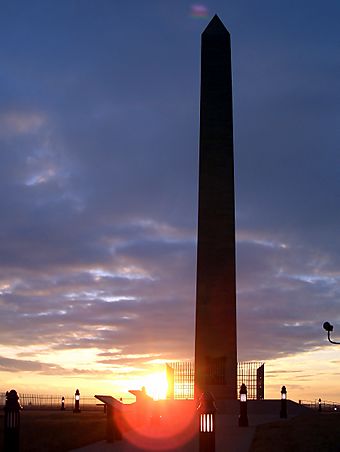Sergeant Floyd Monument facts for kids
|
Sergeant Floyd Monument
|
|

Sergeant Floyd Monument, Sioux City, Iowa
|
|
| Location | S. Lewis Blvd. Sioux City, Iowa |
|---|---|
| Built | Original Memorial: 1804 Current Memorial: 1901 |
| Architect | Floyd Memorial Association of Sioux City |
| Architectural style | Obelisk |
| NRHP reference No. | 66000340 |
Quick facts for kids Significant dates |
|
| Added to NRHP | October 15, 1966 |
| Designated NHL | June 30, 1960 |
The Sergeant Floyd Monument is a special tower built near the Missouri River. It stands on a place called Floyd's Bluff in Sioux City, Iowa, USA. This monument honors Charles Floyd. He was a member of the famous Lewis and Clark Expedition. Charles Floyd sadly died during their journey in 1804 and was buried right here.
This monument was the very first place in the United States to be named a National Historic Landmark. This means it's a really important historical site.
Contents
Who Was Sergeant Charles Floyd?
Charles Floyd (1782–1804) was an explorer for the United States. He was a non-commissioned officer and a quartermaster (which means he was in charge of supplies) for the Lewis and Clark Expedition. Charles Floyd was from Kentucky and was related to William Clark, one of the expedition's leaders. He was one of the first people to join this important journey.
Floyd's Journey and Illness
While exploring the huge area of the Louisiana Purchase with Lewis and Clark, Floyd became sick. This happened at the end of July 1804. On July 31, Floyd wrote in his diary, "I am very sick and has been for sometime but have recovered my health again." But this feeling of getting better didn't last long.
William Clark wrote that Floyd died "with a great deal of composure." Before he passed away, Floyd told Clark: "I am going away. I want you to write me a letter." Sergeant Floyd died on August 20, 1804. The expedition team held a funeral for him. They buried him on a high piece of land overlooking the Missouri River. They named this spot Floyd's Bluff to remember him.
What Caused Floyd's Death?
William Clark thought Floyd's illness was "bilious colic," which meant severe stomach pain. However, doctors and historians today believe Charles Floyd likely died from a burst appendix. This is a small organ attached to the large intestine.
The brief time Floyd felt better might have been when his appendix burst. After that, a dangerous infection called peritonitis would have spread. In those days, there was almost no way to treat a burst appendix, so it was usually deadly.
Building the Monument
Over time, the river's erosion started to wash away Floyd's grave. By 1857, even the original cedar post marker left by the expedition was gone. People who cared about history saved most of his bones, including his skull. They re-buried him about 200 meters east of where he was first laid to rest.
A model of what Sergeant Floyd's face probably looked like, made from a cast of his skull, is on display. You can see it at the Sergeant Floyd Riverboat Museum in Sioux City.
New Interest and Reburials
In 1894, Floyd's journal from the expedition was published. This made people interested in him again. His remains were buried a third time on August 20, 1895. This was the anniversary of his death.
Some people from Sioux City, including Thomas J. Stone and John H. Charles, started the Floyd Association. Their goal was to build a monument for him. It took them five years to raise $20,000. Building the monument began in May 1900 when they poured the concrete base.
Floyd's remains were buried for the last time on August 20, 1900, again on the anniversary of his death. The monument itself is a tall, white stone tower called an Obelisk. It stands 100 feet (30 m) high. It was finished on May 30, 1901.
A National Historic Landmark
In 1960, the U.S. Department of Interior officially recognized the monument. It became the first National Historic Landmark in the United States. This special title was given on June 30, 1960.
Visiting the Monument Today
The Floyd Monument is now part of a 23-acre (93,000 m2) park. Visitors can enjoy a beautiful view of the Missouri River valley from here. Sergeant Floyd's final resting place is located near old U.S. Highway 75. You can find it in the southern part of Sioux City, Iowa.
Images for kids




